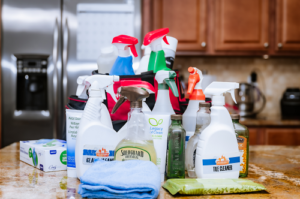Cleaning Supplies: What Every Household Needs to Know
First, a healthy and pleasant home life depends on regular cleaning and tidying up. However, picking the correct supplies might be challenging due to the abundance of cleaning goods on the market. In this manual, we will show homeowners how to shop for cleaning materials efficiently and effectively, saving them time and money.
Think About What You Need to Clean Before You Go to the Store. Factors such as dwelling size, population density, and surface kinds all contribute to wide variations in household cleaning needs. Note any locations that see a lot of foot traffic, any surfaces that need extra care, and any product preferences you may have, such as for non-toxic or environmentally friendly options.

Get back to the fundamentals:
Get started by stocking up on the basics of cleaning equipment and chemicals. For example:
The term “all-purpose cleaner“ refers to a product that may be used on a wide range of surfaces, including kitchen and bathroom appliances, counters, and tile.
Clean windows, mirrors, and other glass surfaces without leaving streaks with this effective glass cleaner.
Disinfectant: a substance used to get rid of germs and bacteria, typically in highly contaminated places like the kitchen or bathroom.
The floor care trinity of broom, mop, and vacuum cannot be neglected.
Think About Purchasing Products Tailored To The Material To Be Cleaned Stainless steel appliances, wooden cabinets, and granite worktops all require different cleaning products. These specialist products are designed to deliver maximum efficacy with minimal risk of harm and residue buildup.
Green, Eco-Friendly, and Non-Toxic Choices If you prefer cleaning products that are less harmful to the environment, keep an eye out for labels that read “green,” “eco-friendly,” or “non-toxic.” These items are made with biodegradable materials to lessen their impact on the environment and the safety of their consumers.
Investigation and Label Perusal:
Be sure to read any warning labels before using a product. Check for obvious usage directions, safety measures, and any other warnings that may apply. If you want to make sure a product is up to par quality-wise and in terms of safety, look for seals of approval from respected agencies like the EPA.
When it comes to cleaning materials, it can be tempting to go for the least expensive option, but remember that you get what you pay for. Purchasing more expensive products may improve outcomes and cut down on maintenance frequency. Evaluate the effectiveness and longevity of each product in relation to its price.
If you come across a new cleaning product, try purchasing a smaller size or sample before making a greater commitment. This way, you won’t have to spend money on a product that doesn’t work or is incompatible with your surfaces.
Once you’ve stocked up on cleaning materials, set aside a space to keep everything neat and easily accessible. Keep them in a secure location out of the reach of children and pets, as recommended by the manufacturer.
Getting the correct equipment for cleaning doesn’t have to be a major hassle. You can keep your home clean and healthy by making educated decisions based on your needs, taking into account surface-specific products, and giving top priority to eco-friendly options. Always check the ingredients, compare pricing, and try before you buy. If you’ve got the correct tools, you can clean just about anything quickly and easily.
